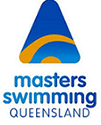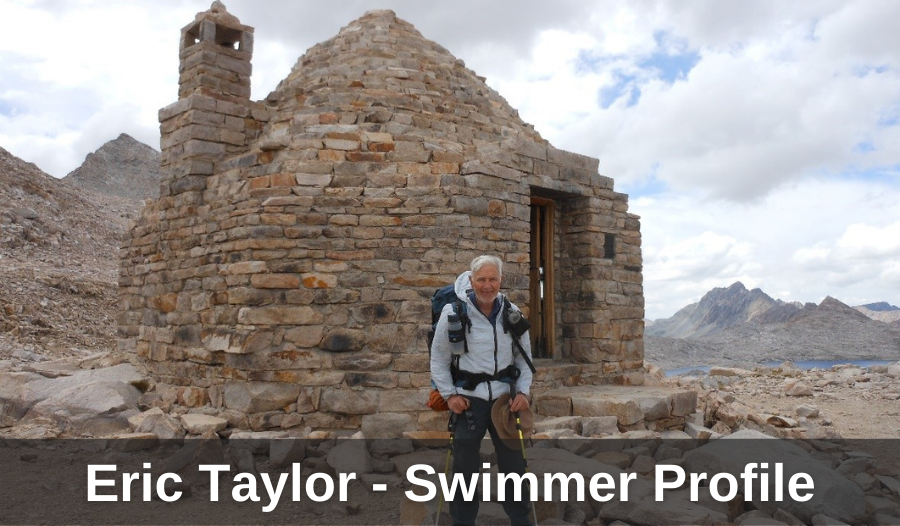
Eric Taylor – Swimmer Profile
Eric is a member of Miami Masters, and has generously shared his story. Enjoy the read!
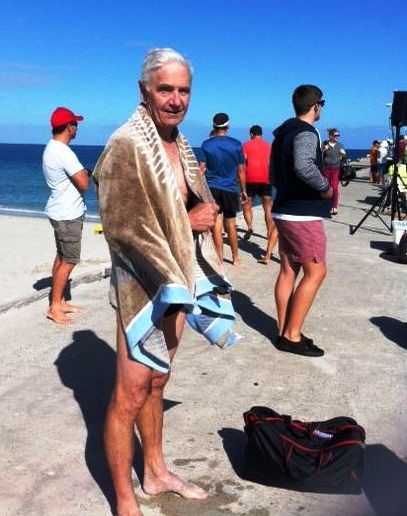
I was raised in Brisbane in Camp Hill, West end (two years) then Seven Hills. My father was born in England and my mother was born of Russian parents in Manchuria. Both arrived in Brisbane at a young age. I attended Buranda State Boys’ Primary School, which was one of the few schools in those days with a 25 yard pool. It was non-chlorinated, they just emptied & refilled it when it got too grotty! Then to Brisbane Boys Grammar and on to Qld Agricultural College (QAC) at Gatton. I completed my Veterinary Science degree at UQ in 1966.Whilst at QAC I had 2 years in the Citizen’s Military Forces now called the Army Reserves. I later realized that being pushed towards your physical endurance level during army field exercises and coping with it; was a good rite of passage for a 17-year-old to experience. I remember one night trying to sleep lying on a sloping rocky track, sopping wet, with water flowing underneath me. To this day I appreciate a warm dry bed.
I had sporty parents, and Dad had us swimming from a very young age both in pools and learning to body surf. There were very few swimming pools in Brisbane in the late 40s and 50s and I can remember going to Ithaca pool for training and swimming at West End Pool for fun and the Valley Pool for school competitions. West End Pool was interesting; 50 yards long about 30 yards wide and the deep section ran down the length of the pool instead of being at one end. Apart from swimming, I played Rugby Union at high school, tennis, water skiing and later, squash.
I didn’t grow up wanting to be a veterinarian, but it was in my DNA to work outside with farm animals and studying Vet Science was a logical progression to that end. Following graduation, I worked for a year in dairy practice in Cohuna on the Murray River and saved my money. Then my mate Rob and I shipped our jointly owned VW sedan to Sri Lanka and ferried it to Southern India. From there we travelled the “Overland” route to England via Nepal, Kashmir, Pakistan, Afghanistan, Iran, Turkey, Europe including going above the Arctic Circle to Finland and Norway. Eventually we arrived in England in September 7 months later. It cost us $US800 each in travelling expenses. I then did vet locum work in England until “lack of sunlight” depression forced me out. After buying out Rob’s half share in the VW, I shipped it to Durban, South Africa where my future wife, Diane joined me. Meantime Rob bought a motor bike, shipped it to Argentina and rode it up to Alaska, then across the USA. Diane and I then travelled through southern Africa and pulled up in Malawi for 6 months, where we both did vet work and got married. Then it was onwards to Tanzania, Uganda and Kenya from where we shipped the VW to Karachi and completed the overland route to England once more. Back in Australia, I worked in large animal practice in Goondiwindi for 5 years, then took up a staff position at the Murdoch University School of Veterinary Studies in Perth until I retired at age 68 in 2009.
My early “hiking” experience if one could call it that, was in the army at 17-18 years old. My second hiking career started late in life at 58. I heard a description of the Bibbulmun track which stretches 1000km from Perth to Albany and decided I was going to do it. I was working, so it took me 18 months to complete it in stages. I was accompanied by my eldest son for a third of the way and the rest I did solo, as were most of my subsequent hikes. I was most impressed when a 70-year-old bloke hiked into the shelter one afternoon looking hale and hearty and this encouraged me to keep active. The Bib track experience got me going. Later as I completed other hikes, I realized just how well the Bib track is set up and maintained, mainly by volunteers. Good, 3-sided sleeping and eating area shelters with water tanks and a toilet are provided at each site. Having clean, reliable water is vital to hikers.
What I like about hiking is being out in nature and that it takes you back to the basics of sourcing food, water, shelter and being exposed to the elements. In our urban environments I think we often take these things for granted.
Over time I hiked, the Larapinta Trail (NT), the Great Ocean Way (Vic) the Cape to Cape (WA) and in the Flinders ranges (SA) in Australia. The hardest and most spectacular of these in Australia was the Larapinta trail which runs 220 km between Alice springs and Mt Sonder along the MacDonnell ranges. It takes around 15 days to hike.
The pic below is taken at Count’s lookout and I am looking way back to the start of the hike at Mt Sonder in the distance.
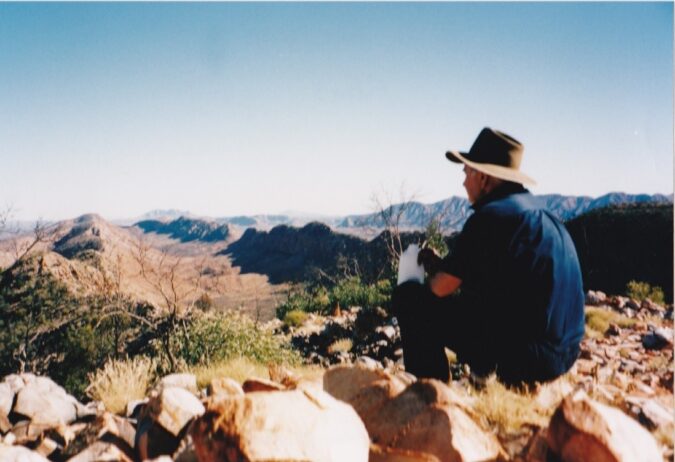
In 2003 it was a wilderness experience as except for 3 tourist access sites, there were no shelters or toilets, and water tanks or water holes were only available at some locations. Since then, water tanks have been provided at each trail head. This trail was notable because it’s tough hiking over very rough terrain in semi desert conditions, with temperatures in July ranging from -2 at night to 27 degrees C, daytime. On 2 sections I had to carry 8L (8Kg) as my only water supply. I was advised to keep my food and leather boots inside my tent at night out of dingo reach. They were about, I heard them howling at night. A fire had burnt through a large section of the track in 2002, destroying the track markers. Rangers had tied ribbons to burnt trees as temporary markers but some were blown away. On one occasion I needed to take a compass bearing and I followed that across a valley to the next gorge through the range. The rocky terrain was hard on knee and ankle joints and I sprained my ankle 5 days from the end. With ankle strapping and the aid of a walking stick I managed to hobble onwards to the finish.
In New Zealand I hiked four of their “Great Walks”. One of the most enjoyable was the Marlborough sound track (See pic below).
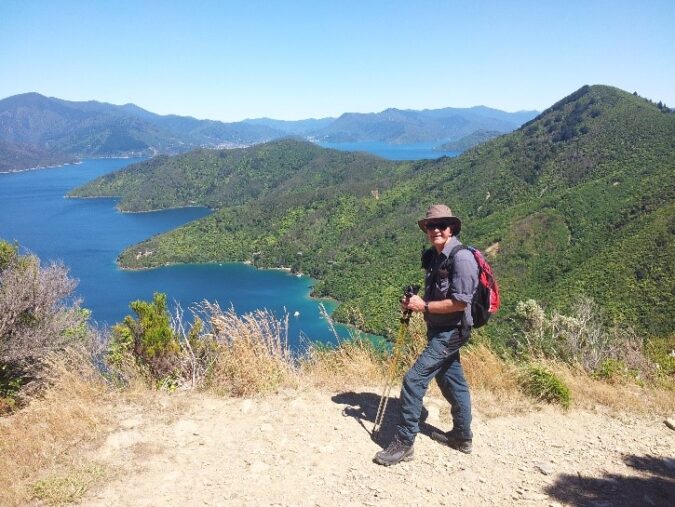
and later the Milford track. (See pic below of me at the top of the Mackinnon pass, 3500 feet)

Subsequently I hiked the Lycian way in Turkey, the Coast to Coast across England and the John Muir (JM) trail in The Sierra Nevada’s of California in 2012. The JM trail runs between Yosemite NP and Mt Whitney. It was the hardest physical challenge I’ve ever faced. It is a wilderness track with magnificent alpine scenery. Except for three tourist access points, there are no shelters, toilets or provided water, albeit natural water sources are plentiful. It is 220 miles long and traverses 8 alpine passes and most hikers do it in 22 days or so. Not that far but it requires you to see-saw from 7-8000ft up to 11,12 or 13,000 feet and back down again as you cross the passes. At these altitudes, oxygen depletion and some symptoms of oxygen sickness are common, and I was exhausted at the end of each day. On the JM trail it is obligatory to carry a bear canister. The one I used was a large titanium cylinder with a lid sealed by screws, which brown bears can’t open. All your dehydrated food is packed into the canister and it is placed about 40 metres away from your tent at night so bears can have free access to it and hopefully leave you and the tent alone. It’s best not to leave it on a slope above a creek. Bears have been known to roll a canister into a creek below. The last 10-day section of the track is very isolated, traverses the highest passes and requires you to carry enough food with you. Trying to fit 10 days’ supply of food into the bear canister and then trying to fit that into your backpack is a real challenge! Most hikers who quit the trail do so prior to this last 10-day stretch.
(See pic below of the John Muir hut at the JM pass, 11,955 feet)
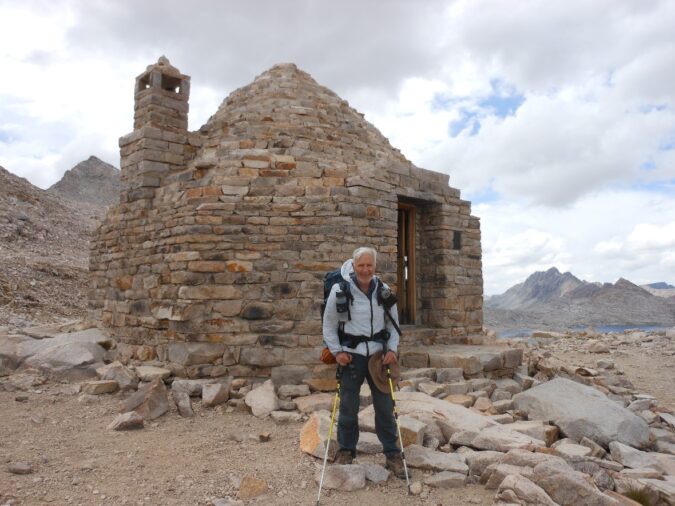
It is obligatory to book in start and finish dates on the JM trail and I made the big mistake of plugging in my dates based on the itinerary of a Victorian couple who were in their mid-thirties and had published their JM trail experience in a hiking magazine. I didn’t think at the time that they may do it at a faster pace that someone in their seventies and due to my inexperience of hiking at altitude, I seriously underestimated the effects of low oxygen intake on my hiking ability. Who said you get wisdom with age?
Most hikers who attempt the JM trail are 20 to 30-year-olds. This is shown in the picture below where I’m with a group of fellow hikers at Vermillion Valley Resort. At this site I picked up a food resupply box and had a rest day. On the JM trail, it was very frustrating for me when I was slowly moving up to the next pass and these “kids” would breeze past me, full of energy and leave me struggling in their wake.

My competitive swimming career was in hiatus from 1960 until one day in early 2013 when I spotted a Masters’ Swimming sign at our local indoor 50m pool. I decided to give it a go and joined the Riverton Masters Club. My first swim competition was about two months later at the WA Masters States Swim at Challenge Stadium indoor pool. This was an absolute revelation. Incredibly well organized, electronic score board, look up from the pool and see your name, race position and time up in lights immediately upon finishing the race, how good was that! I entered in 100m, 50m freestyle, and breaststroke events and of course I was unseeded. First race I was in with a bunch of oldies.
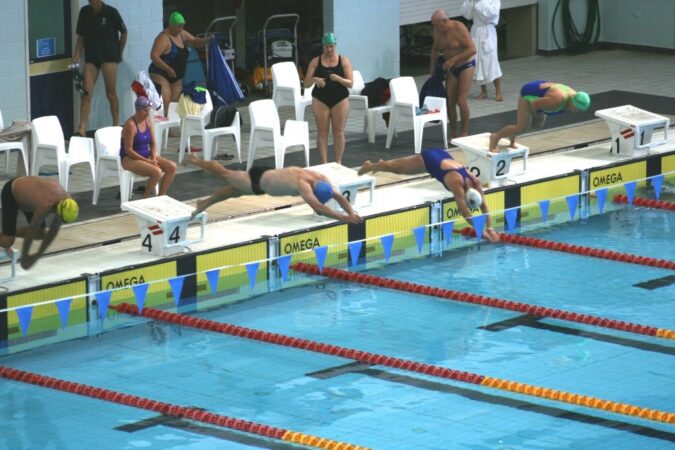
I was off the blocks like a shot (see pic, I’m in the blue cap) & then proceeded to clean up the field. So it was for my next two races. I was thinking “this masters swimming is good fun I’m a star!” In my next swim competition, I was seeded and it was rooster to feather duster in one fell swoop. I soon realized that in my age range of 70-80 years, there were many swimmers who were more fit and faster than was! But I enjoyed my moment of glory. One thing that really impressed me at the WA states was the masters’ spirit. No matter how slow, or uncoordinated their swimming, swimmers were applauded when they finished. The clear message I got was “we will always support you if you just have a go”. One club only catered for disabled swimmers and it was great to see them try their hearts out and enjoy being with their mates. A man with one leg swam several races…quite fast. A little 84-year-old lady tottered along the pool deck, literally fell into the pool at the start and completed her 100m race two minutes after everyone else and was well applauded. I found all this inspirational. I saw many older people who were obviously very fit and realized that age is no barrier to fitness.
Apart from pool swimming, I competed in three open water swims per year in WA and enjoyed it. They invariably went first thing in the morning and a BBQ breakfast was laid on afterwards, a good way to finish off the swim.
One advantage of being in masters’ swimming is that you can be anywhere in the world, lob up to a local club and join them for a swim. My partner Pat and I were doing a twice-yearly migration to Currumbin for several years and I went along to Miami Masters on Saturday afternoons. Initially this was during the halcyon days of “Lane 11” when having drinks (including moderate alcohol) and nibbles was a very pleasant way to round off the afternoon. During this time, I joined the occasional Kirra offshore swim and then Peter Mitchell introduced me to the Burleigh-to-Burleigh swim. Up to that stage I’d only swum 800m in one go. After the first swim, I asked how far it was and we’d covered 1.7km. I didn’t think I could swim that far! Now I like to join them on Wednesdays when parking is easy.
This year we bought and renovated a unit at Currumbin so now I’m a permanent member of the Miami club. With the renovations behind me, I‘d like to ease back into competitive swimming…which I think is a good impetus to purposeful training.

